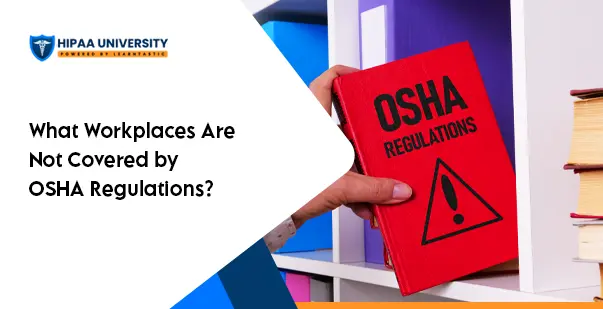What Workplaces Are Not Covered by OSHA Regulations?

September 3, 2024
Table of Contents:
- Introduction
- What Is OSHA and Why Is It Important?
- Workplaces Not Covered by OSHA Regulations
- Does OSHA cover self-employed?
- Potential Risks for Workers in Exempt Workplaces
- Alternatives to OSHA for Ensuring Workplace Safety
- Final Thoughts
When it comes to staying safe at work, OSHA(Occupational Safety and Health Administration) is one of the most important names to know. It is a government firm that ensures workplaces are safe for all workers. Whether you’re working in a factory, an office, or a construction site, OSHA sets the rules to keep you protected.
The OSHA regulations cover everything from handling dangerous chemicals to operating heavy machinery. However, not every workplace is covered by OSHA regulations. Some places, like small family farms or certain public-sector jobs, aren’t covered by OSHA. This means the safety of workers in these areas might depend on other regulations or the workers themselves.
Therefore, understanding what OSHA does and why it matters is key to recognizing how safety works in different types of jobs. In this guide, we will explore what OSHA is, its regulations, and what businesses OSHA does not cover.
What Is OSHA and Why Is It Important?
In 2019, there were around 5,333 fatal workplace injuries, highlighting the importance of workplace safety. In order to prevent such workplace hazards, the Occupational Safety and Health Act (OSHA) was enacted in 1970 to protect workers from unsafe conditions that could cause injury, illness, or death. It sets standards for things like machinery safety, chemical exposure, fire safety, and more. These standards will thus help prevent accidents and ensure that workers are treated fairly.
However, while OSHA covers many workplaces, it doesn’t cover all of them. Some are excluded due to the nature of the work, the type of employer, or the specific laws that govern them.
Workplaces Not Covered by OSHA Regulations
Not all workplaces are covered by OSHA regulations. This means that some businesses and employees are exempt from these rules, either because other federal agencies handle their safety or because the government believes they can manage safety on their own. Now, if you are wondering, Osha does not cover what businesses; here is a list of workplaces where OSHA regulations do not apply:
-
Immediate Family Members of Farm Employers
Farms that employ only immediate family members are exempt from OSHA regulations. This exception is in place because these farms are often small, family-run businesses. The law assumes that family members working together have their ways of ensuring safety without needing federal oversight.
Why They Are Exempt: Family members are thought to have a built-in motivation to keep the workplace safe because of their investment and the close relationships within the business. The government believes that these families are capable of taking care of their safety without the need for strict federal rules, so it doesn’t apply OSHA regulations to them.
-
Workplaces Regulated by Other Federal Agencies
Some workplaces fall under the jurisdiction of other federal agencies that have their own safety and health regulations. For example:
- Mining: The Mine Safety and Health Administration (MSHA) regulates mining activities. MSHA sets specific standards for mine safety, so OSHA does not cover this industry.
- Nuclear Power Plants:The Nuclear Regulatory Commission (NRC) regulates nuclear power plants. The NRC has its safety standards, so OSHA does not cover these facilities.
- Transportation: The Department of Transportation (DOT) regulates many aspects of transportation, such as aviation, trucking, and railroads. The DOT has its own safety rules, so OSHA does not cover these areas.
These industries have specialized risks that require oversight by agencies with specific expertise, which is why OSHA does not cover businesses in these fields.
Why They Are Exempt: These industries face unique risks that require specialized knowledge and oversight. Agencies like MSHA, NRC, and DOT have the expertise needed to create specific safety rules for these industries. Because these agencies are better equipped to handle these specialized areas, OSHA steps back and lets them take the lead.
-
Public Sector Employees in State and Local Governments
OSHA regulations do not cover state and local government employees unless they work in states that have OSHA-approved state plans. In states without such plans, public sector employees, including police officers, firefighters, and public school teachers, are not covered by federal OSHA regulations. However, some states have their own occupational safety and health programs that protect these workers.
Why They Are Exempt: Public sector employees are usually covered by state or local government safety programs instead of federal OSHA. This allows states to create rules that better suit their specific needs than a one-size-fits-all federal regulation.
-
Workplaces in U.S. Territories and Outside the U.S.
OSHA only covers the United States and its territories. However, not all U.S. territories are covered. For example, OSHA regulations do not apply to American Samoa. Additionally, U.S. workplaces located outside the country, such as embassies or military bases, may not be covered by OSHA. In these cases, other safety standards and regulations may apply.
Why They Are Exempt: OSHA only has authority in certain areas. In places like American Samoa or overseas U.S. workplaces, other rules or agencies take charge of safety, so OSHA does not apply its regulations there.
-
Volunteers
Volunteers are not considered employees, so OSHA does not cover what type of business that relies on volunteer labor. This includes volunteers at nonprofit organizations, community events, and other activities where people work without pay. Since there is no employer-employee relationship, OSHA does not have authority over these situations.
Why They Are Exempt: OSHA’s rules are designed to protect employees at work. Because volunteers are not paid and do not have an official employer, OSHA doesn’t regulate their activities. However, it’s still important for organizations to keep volunteers safe.
-
Religious Organizations
Religious organizations, such as churches, mosques, and synagogues, are often exempt from OSHA regulations, especially when the work involves religious practices. However, if a religious organization operates a business, like a daycare or a thrift store, the employees of that business may be covered by OSHA. The distinction is usually made based on the nature of the work and whether it’s related to the religious mission of the organization.
Why They Are Exempt: Religious practices are often considered private matters, so OSHA does not usually regulate them. However, if a religious organization runs a business that is more like a regular workplace, OSHA may apply its rules to protect employees.
-
Certain Small Farms
Small farms with fewer than 10 employees that do not provide temporary labor camps are also exempt from OSHA. This exemption is due to a specific provision in the law that aims to protect small family-run farms from federal regulation. The idea is that these small operations do not pose the same risks as larger farms or industrial workplaces.
Why They Are Exempt: Small farms with very few workers are seen as lower-risk environments. The government wants to support these small businesses without burdening them with complex regulations, so they are exempt from OSHA rules.
Also Read: Who Must Comply with HIPAA Rules and Regulations?
Does OSHA Cover Self Employed?
One of the most common questions is, does OSHA cover self employed workers? The answer is no. OSHA’s rules only apply to workplaces where there is an employer-employee relationship.
Self-employed individuals, like freelancers or independent contractors, do not have an employer. Since there is no responsible fis or their safety, OSHA does not regulate their work environment. This means self-employed workers must take care of their safety. They are responsible for following safe practices and making sure their work environment is hazard-free.
While OSHA provides guidelines and resources that anyone can use, self-employed workers are not legally required to follow OSHA regulations. Self-employed individuals need to stay informed about safety practices to protect themselves while working.
Potential Risks for Workers in Exempt Workplaces
Workplaces exempt from OSHA regulations can face unique safety challenges. Without OSHA’s guidance, workers in these environments might be more vulnerable to accidents and injuries. The potential risks that employees may encounter include:
- Lack of Safety Training and Equipment:
Self-employed workers may not have access to safety training or protective equipment. Without an employer, they might be unaware of the risks in their work or lack the tools to protect themselves.
- Exposure to Hazards on Small Family Farms:
Family members working on small farms might be exposed to dangerous machinery or chemicals without the same safety protections as larger farms. The absence of strict safety rules can lead to accidents.
- Inconsistent Protection for Public Sector Employees:
Public sector employees in states without OSHA-approved plans may not receive the same level of protection as those in states with OSHA oversight. This can lead to different safety standards for the same job, depending on the location.
- Responsibility on Workers and Employers:
In exempt workplaces, safety often depends on the workers and employers themselves. Small businesses and individual workers might struggle to implement proper safety measures due to limited resources or knowledge.
- Increased Risk of Accidents and Injuries:
Without OSHA’s guidance, these workplaces may have gaps in their safety practices, leading to a higher risk of accidents and injuries.
Also Read: What is HIPAA Violation?
Alternatives to OSHA for Ensuring Workplace Safety
Even if OSHA doesn’t cover a workplace, there are still ways to keep workers safe. Various alternatives can be used to maintain a safe working environment and protect employees from harm. Here are some alternatives:
- State Occupational Safety and Health Plans
Many states have their own occupational safety and health programs, often referred to as “state plans.” OSHA approves these programs, which must be at least as effective as federal regulations. State plans cover public sector employees and sometimes offer more protections than federal OSHA.
- Industry-Specific Regulations
Industries not covered by OSHA, such as mining and nuclear power, are regulated by other federal agencies. These agencies set standards designed to protect workers from specific hazards. For example, MSHA regulates mine safety, while the NRC oversees nuclear safety.
- Voluntary Safety Programs
Employers can choose to implement voluntary safety programs even if they are not required to do so by OSHA. These programs include safety training, regular inspections, and the use of personal protective equipment (PPE). By adopting these measures, employers can create a safer work environment and reduce the risk of accidents.
- Worker Education and Training
Workers can take steps to protect themselves by educating themselves about the risks in their workplace and learning how to stay safe. This might involve taking safety courses, reading safety manuals, or attending training sessions. In some cases, trade associations or unions offer safety training and resources to help workers stay safe.
- Insurance Requirements
Some businesses are mandated to have workers’ compensation insurance that may provide coverage in case of job-related injuries. Though it does not prevent accidents, it can at least ensure that workers receive medical care and compensation in case of injury. Sometimes, insurance companies also insist that the business firms take safety measures to minimize the possibility of claims.
Final Thoughts
OSHA ensures workplace safety, but its regulations do not cover every workplace. Self-employed workers, small farms, religious organizations, and certain other workplaces are exempt from OSHA’s jurisdiction. While these exemptions reduce the regulatory burden on some businesses, they also place greater responsibility on workers and employers to maintain a safe working environment.
Thus, workers in exempt workplaces should remain aware of the risks they face and take steps to protect themselves. Whether through state plans, industry-specific regulations, or voluntary safety programs, there are ways to ensure safety even when OSHA does not cover it. To enhance your workplace safety knowledge—enroll in an OSHA course today and ensure a safer environment for yourself and your team!





